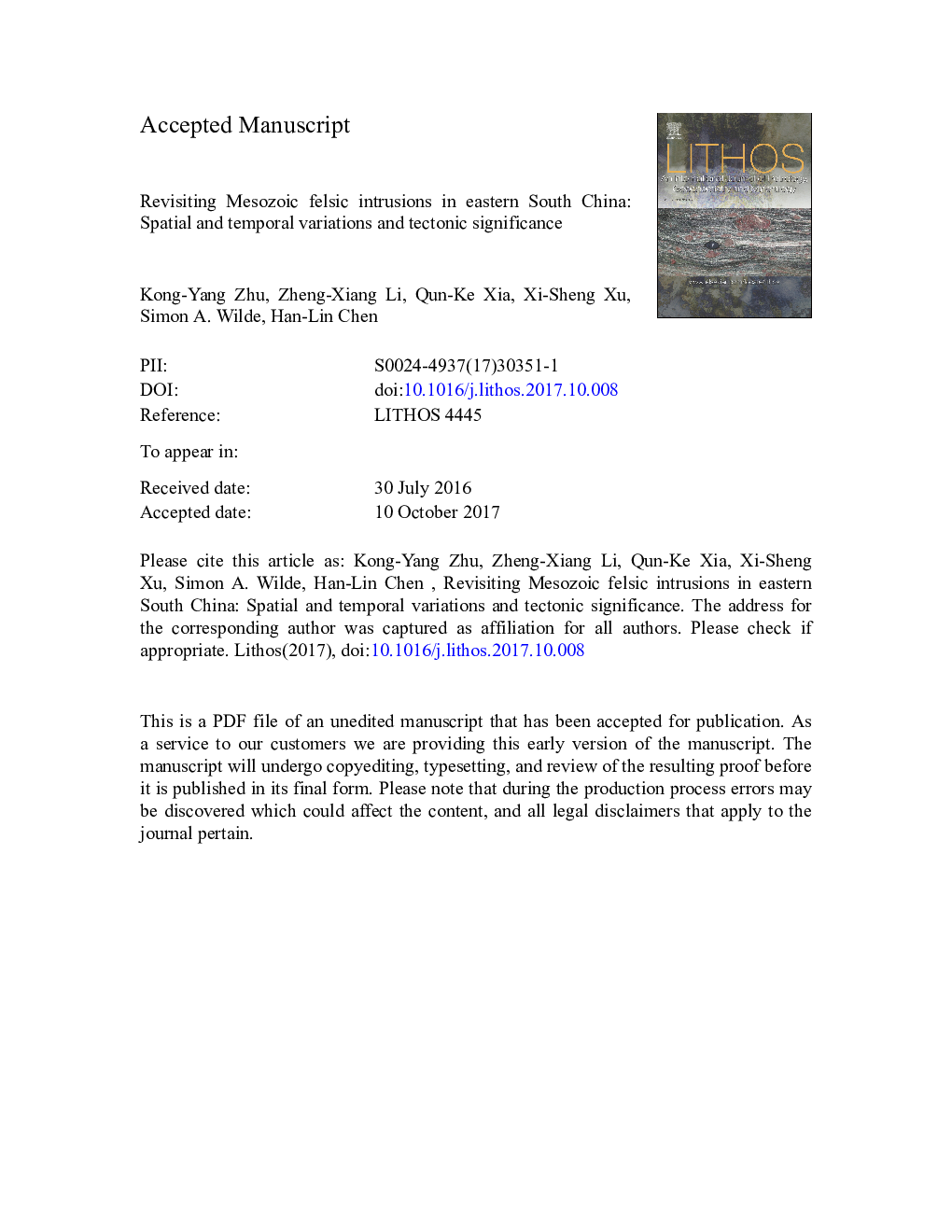| کد مقاله | کد نشریه | سال انتشار | مقاله انگلیسی | نسخه تمام متن |
|---|---|---|---|---|
| 8911852 | 1638625 | 2017 | 68 صفحه PDF | دانلود رایگان |
عنوان انگلیسی مقاله ISI
Revisiting Mesozoic felsic intrusions in eastern South China: spatial and temporal variations and tectonic significance
ترجمه فارسی عنوان
بازخوانی نفوذ فلسکی مزوزوئیک در شرق چین جنوب: تغییرات فضایی و زمانی و اهمیت تکتونیکی
دانلود مقاله + سفارش ترجمه
دانلود مقاله ISI انگلیسی
رایگان برای ایرانیان
کلمات کلیدی
سنگ گرانیت، سینیت مشتق شده از پوسته، مزوزوئیک، شرق چین جنوبی،
موضوعات مرتبط
مهندسی و علوم پایه
علوم زمین و سیارات
ژئوشیمی و پترولوژی
چکیده انگلیسی
Whole-rock and mineral geochemical data are used to place new constraints on the petrogenesis and tectonic setting of Mesozoic granitoids (including syenites) in eastern South China. In the Early Mesozoic, granitoids of variable compositions were intruded in the Cathaysia Block which by this time had developed a thickened and highly differentiated Paleoproterozoic crust through the influence of subduction. Late Triassic (~Â 225Â Ma) syenites are significantly different from Jurassic-Cretaceous syenites in South China and from most trachytes (GEOROC database) in terms of their high Th/U, La/Nb and Gd/Yb ratios. Their low Rb contents, coupled with their high K/Rb and Nb/Ta, and low 87Sr/86Sr and 206Pb/204Pb ratios suggest a source that had undergone granulite-facies metamorphism at the base of thickened (>Â 45Â km thick) continental crust where garnet and rutile are stable. The Late Triassic alkaline intrusions thus appear not to be related to continental rifting. Compared with the Late Triassic syenites, contemporaneous syenogranites have higher Ga/Al and Rb/K ratios and ISr values. Their Ga/Al ratios are positively correlated with ISr values, and their higher Ga/Al ratios likewise do not appear to be related to a rift setting but reflect the composition of the source. New Pb isotopic data from Cretaceous magmatic rocks reveal that 120-100Â Ma I-type granitoids in Zhejiang Province were likely derived from mixing of three components: contemporaneous basaltic magma, an enriched crustal component and a depleted crustal component. Pb isotopes of both the I-type granitoids and the basalts become more radiogenic towards the coast, where the ca. 100Â Ma intrusions dominate. Furthermore, zircon-melt partition of Ce and hornblende oxygen barometries indicate that the Early Cretaceous intrusions also became more oxidized towards the coast. In addition, the ca. 100Â Ma granitoids have higher Gd/Yb and lower Fe/Mg ratios than those of the 120-110Â Ma suite, implying crustal thickening resulting from 120 to 100Â Ma basaltic underplating in the region.
ناشر
Database: Elsevier - ScienceDirect (ساینس دایرکت)
Journal: Lithos - Volumes 294â295, December 2017, Pages 147-163
Journal: Lithos - Volumes 294â295, December 2017, Pages 147-163
نویسندگان
Kong-Yang Zhu, Zheng-Xiang Li, Qun-Ke Xia, Xi-Sheng Xu, Simon A. Wilde, Han-Lin Chen,
